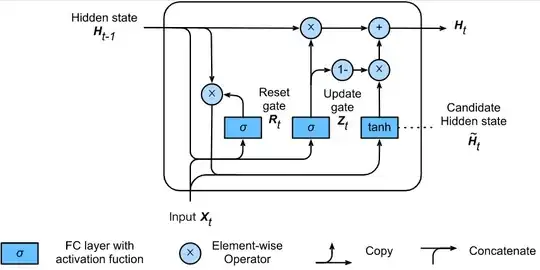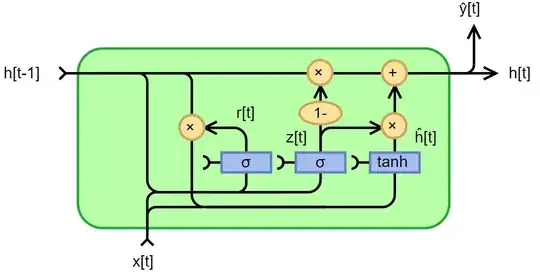Looking into GRU equation I see 2 type for final output. One is from, https://d2l.ai/chapter_recurrent-modern/gru.html#hidden-state, that is,
$ \mathbf{R}_t = \sigma(\mathbf{X}_t \mathbf{W}_{xr} + \mathbf{H}_{t-1} \mathbf{W}_{hr} + \mathbf{b}_r) \\ \mathbf{Z}_t = \sigma(\mathbf{X}_t \mathbf{W}_{xz} + \mathbf{H}_{t-1} \mathbf{W}_{hz} + \mathbf{b}_z) \\ \tilde{\mathbf{H}}_t = \tanh(\mathbf{X}_t \mathbf{W}_{xh} + \left(\mathbf{R}_t \odot \mathbf{H}_{t-1}\right) \mathbf{W}_{hh} + \mathbf{b}_h) \\ \mathbf{H}_t = \mathbf{Z}_t \odot \mathbf{H}_{t-1} + (1 - \mathbf{Z}_t) \odot \tilde{\mathbf{H}}_t $
There it is mentioned,
whenever the update gate $Z_t$ is close to 1, we simply retain the old state. In this case the information from $X_t$ is essentially ignored, effectively skipping time step t in the dependency chain. In contrast, whenever $Z_t$ is close to 0, the new latent state $H_t$ approaches the candidate latent state $\tilde{H}_t$ .
Another one from Wikipedia,
$ z_{t} = \sigma _{g}(W_{z}x_{t}+U_{z}h_{t-1}+b_{z}) \\ r_{t} =\sigma _{g}(W_{r}x_{t}+U_{r}h_{t-1}+b_{r}) \\ {\hat {h}}_{t} =\phi _{h}(W_{h}x_{t}+U_{h}(r_{t}\odot h_{t-1})+b_{h}) \\ h_{t} =(1-z_{t})\odot h_{t-1}+z_{t}\odot {\hat {h}}_{t} $
They both produce different values when working with sample vectors. My question is, are they both correct and if so is there any particular reason the first equation is implemented in major Deep Learning libraries?
My confusion is between, $\mathbf{H}_t = \mathbf{Z}_t \odot \mathbf{H}_{t-1} + (1 - \mathbf{Z}_t) \odot \tilde{\mathbf{H}}_t$ and $\mathbf{H}_t = \mathbf{Z}_t \odot \mathbf{\tilde{H}}_{t} + (1 - \mathbf{Z}_t) \odot \mathbf{H}_{t-1}$. In the latter equation when $Z_t$ is close to 1 then the new latent state $H_t$ approaches the candidate latent state $\tilde{H}_t$. It is doing opposite of what is mentioned previously.
Following keras and pytorch implementation it seems, $\mathbf{H}_t = \mathbf{Z}_t \odot \mathbf{H}_{t-1} + (1 - \mathbf{Z}_t) \odot \tilde{\mathbf{H}}_t$ is implemented on code.

